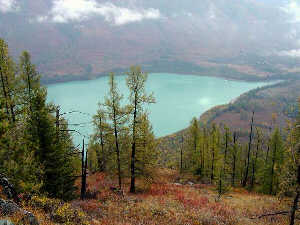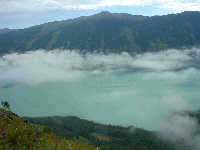| |
Kanas Lake
( 2005-09-13 )
 Isolated from the outside world and remaining undeveloped by human beings, Kanas is acclaimed as one of the few pure spots of lands still left on earth. Isolated from the outside world and remaining undeveloped by human beings, Kanas is acclaimed as one of the few pure spots of lands still left on earth.
The Kanas Nature Reserve is located in the heart ofXinjiang's Altai Region that borders Russia, Kazakhstan, and Mongolia. Its name, Kanas, is a Mongolian word that means "a beautiful and mysterious place." It is estimated that theKanas Lake, as the core of the Kanas Natural Reserve, formed some 200,000 years ago, due to glacier development during the last Ice Age.
The nature reserve is best known for the picturesque Kanas Lake, which was formed through strong plowing by glaciers. About 1,375 meters above sea level, the crescent-shaped alpine lake covers an area of 44.78 square kilometers -- ten times the size of theHeavenly Lakein the Tianshan Mountains. It reaches about 180 meters at the deepest point, making it the deepest alpine freshwater lake in China.
Under the blue sky and the fluffy white clouds, the lake water is as limpid as a mirror, decorated with the reflections of the snow-capped mountains and dense forests. A notable feature of the lake is that the water changes its color with the changing of the seasons and weather. Within a single day, the water's color may turn from green to blue, gray, or white.
 The Kanas Lake is an extension of the European eco-system, which is very rare in China. In this natural reserve, there are 798 kinds of plants, of which 30 kinds are rare plants, 39 kinds of animals, 117 kinds of birds, and 7 kinds of fishes. Of these animals, 5 kinds are under Grade I protection of the State, 13 kinds are under the State's Grade II protection, while 9 kinds are other rare animals. In addition, the number of the recorded new species of insect and eubacterium (kinds of bacteria) is not less than 60. The Kanas Lake is an extension of the European eco-system, which is very rare in China. In this natural reserve, there are 798 kinds of plants, of which 30 kinds are rare plants, 39 kinds of animals, 117 kinds of birds, and 7 kinds of fishes. Of these animals, 5 kinds are under Grade I protection of the State, 13 kinds are under the State's Grade II protection, while 9 kinds are other rare animals. In addition, the number of the recorded new species of insect and eubacterium (kinds of bacteria) is not less than 60.
Around the lake are thick and green theropencedrymion (a kind of plant) that integrates with the grasslands in the mountains. As its name indicates, Kanas proves to be a magical and appealing place for people of all ages, who are fascinated by the enchanting primitive beauty of its undulating mountains, crisscrossing ravines and gullies (water-made ravines), luxurious forests and grasslands, clear waters, and fresh air.
In spring, various flowers are in blossom in the grassland, and the grass is thick and green. When viewed from the grass, the clouds and mist nearby look like white ribbons round mountains. In the distance are snow-capped mountains on which thick forests grow.
|
|

